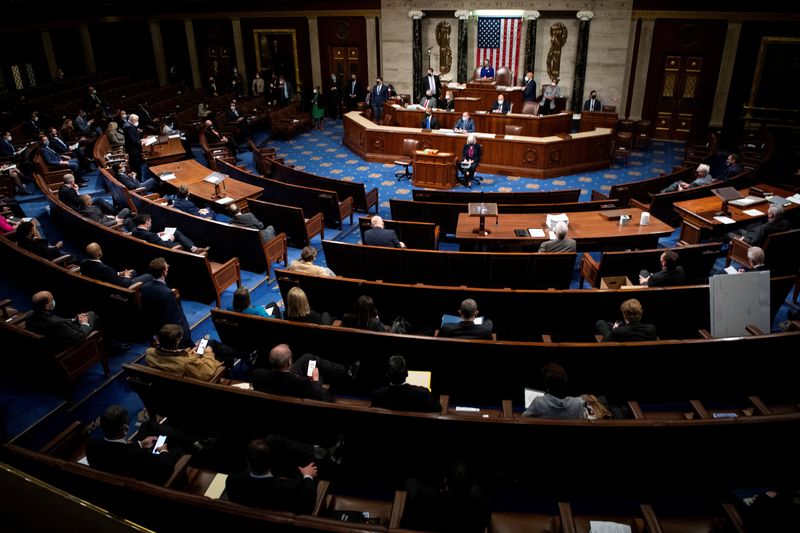By Tom Hals
(Reuters) -In the United States, a candidate becomes president not by winning a majority of the national popular vote but through a system called the Electoral College, which allots electoral votes to the 50 states and the District of Columbia largely based on their population.
Here are some of the rules that could decide the Nov. 5 contest between Vice President Kamala Harris and Republican challenger Donald Trump.
WHAT IS THE ELECTORAL COLLEGE?
When voters go to the polls to pick a president, they usually only see the names of the presidential and vice presidential candidates. However, voters are actually voting for a group — or "slate" — of electors.
Nationally, there are a total of 538 electoral votes, or electors, meaning a candidate needs to secure 270 to win.
Electors are typically party loyalists who pledge to support the candidate who gets the most votes in their state. Each elector represents one vote in the Electoral College.
In 2020, President Joe Biden won 306 electoral votes to defeat Trump, who had 232 electoral votes.
The system, mandated by the U.S. Constitution, was a compromise between the nation's founders, who debated whether the president should be picked by Congress or through a popular vote.
DO STATES HAVE THE SAME NUMBER OF ELECTORS?
No.
Each state has as many electors as it has representatives and senators in Congress. There are two senators for each state, but the allocation of seats in the House of Representatives varies based on population.
California, the most populous state, has 54 electors.
The six least-populous states and the District of Columbia have only three electoral votes, the minimum number allotted to a state.
This means that one electoral vote in Wyoming, the least-populous state, represents about 192,000 people, while one vote in Texas, one of the most underrepresented states, represents about 730,000 people.
All but two states use a winner-take-all approach: The candidate that wins the most votes in that state gets all of its electoral votes.
Winning a state by a large margin is the same as winning by one vote, so campaigns tend to focus on states where a small shift can deliver all of its electoral votes. In the current election, battleground states include Arizona, Georgia, Michigan, North Carolina, Nevada, Pennsylvania and Wisconsin.
CAN A CANDIDATE WIN THE ELECTION DESPITE LOSING THE POPULAR VOTE?
Yes.
Republican George W. Bush in 2000 and Trump in 2016 both became president despite losing the popular vote. It also happened three times in the 1800s.
This is often cited by critics as the main flaw of the system.
Proponents of the electoral college say it forces candidates to seek votes from a range of states, rather than just piling up support in big urban areas.
WHEN DO ELECTORS VOTE?
The electors will meet on Dec. 17 to officially cast their votes and send the results to Congress. The candidate that wins 270 electoral votes or more becomes president.
Those votes are officially tallied by Congress on Jan. 6 and the president is sworn in on Jan. 20.
DO ELECTORS EVER GO ROGUE?
Generally, the meeting of electors is a ceremonial event where they simply rubber-stamp votes for the candidate who won their respective states.
But in 2016, seven of the 538 electors recorded their vote for someone other than their state's popular vote winner, an unusually high number. Three of these seven electors voted for Colin Powell, a former U.S. secretary of state, even though they represented states that picked the Democratic candidate, Hillary Clinton. Trump ultimately won that election.
Thirty-three states and the District of Columbia have laws, some of which include criminal penalties, to try to prevent "faithless" electors from voting for someone else, according to the National Conference of State Legislatures.
WHAT HAPPENS IF THERE'S A TIE?
One of the flaws of the system is that it can theoretically produce a 269-269 tie. If that occurs, a newly elected House of Representatives would decide the fate of the presidency on Jan. 6, with each state voting as a unit, as required by the 12th Amendment of the U.S. Constitution.
Currently, Republicans control 26 state delegations, while Democrats control 22. Minnesota and North Carolina are tied between Democratic and Republican members.
WILL THE ELECTORAL COLLEGE SYSTEM EVER CHANGE?
Congress tried to repair flaws that were exposed after the 2020 election, when Trump falsely claimed he won. Prosecutors have said he pressured state officials to try to overturn the result.
In 2022, Congress passed the Electoral Count Reform Act to clarify that each state's governor or other official chosen by the state will certify the state's election results before they are delivered to Congress.
The new law also aims to prevent a repeat of the 1876 election deadlock when three states submitted "dueling slates of electors" -- one slate certified by the state's lawmakers and a competing slate by a state official.

The law also set a mandatory deadline for certifying results, giving states 36 days after the 2024 election to complete recounts and litigation.
Abolishing the Electoral College would require a constitutional amendment.